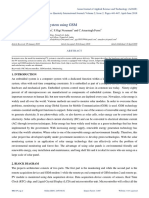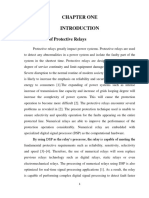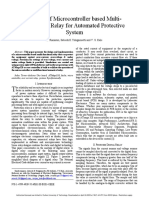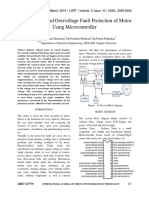Single Phase Differential Transformer Protection Using Arduino
Uploaded by
Hana AliSingle Phase Differential Transformer Protection Using Arduino
Uploaded by
Hana AliInternational Journal of Scientific Research in Engineering and Management (IJSREM)
Volume: 06 Issue: 05 | May - 2022 Impact Factor: 7.185 ISSN: 2582-3930
Single Phase Differential Transformer Protection Using Arduino
1
Prof. Pradnya Korde, 2Isha Bandhe, 3Jayashri Nanaware, 4Chetan Dhawalei, 5Pragati Koche , 6Shreyash Jane, 7Vishal
Raut , 8Suruchi Kathane
1
Professor, Department of Electrical Engineering , NIT Polytechnic, Nagpur
2345678
Students , Department of Electrical Engineering , NIT Polytechnic, Nagpur
Abstract- into serious faults. Incipient faults include loose connection
Transformers are the important parts in the power system. in conducting path, sparking, small arcing etc.
So, development of better protection device for
Transformers is essential. Differential relay technique can be 2. Literature Review
employed to protect the Transformers. In this paper we have Manishay. Nikwade Et. Al. 2020, Transformers are
used differential relay mechanism with Arduino. By the foremost important devise within the facility. Therefore,
programming in the Arduino the protection of transformers the continual operation is incredibly necessary. Permanently
can be done. The working of transformer is verified by protection should create for transformers. Differential
Arduino every time. It senses the condition of transformer protection technique we are able to use to guard the
each and every second. If it founds any error then it sends transformers. During this project, we have got used relay
commands to the circuit breakers to trip the main potential driver mechanism with GSM 800 module. The GSM and
transformer. So it is the efficient and best method to protect IOT are synchronized with Arduino microcontroller.
the transformers under abnormal conditions. Arduino UNO microcontroller is extremely high speed and
Keywords: Transformers, Differential Current Protection, low cost device with more accuracy. A recent huge interest
Arduino Board. in Machine to Machine communication is thought because
the Internet of Things (IOT), to permit the chance for
1. Introduction autonomous system to use Internet for data exchanging. This
Transformers are the important equipment’s in the work presents design fault detection of transformer and
power system. Therefore, the continuity of its operation is record key operation indictors of a dispersion transformer
very necessary. So better protection scheme should develop like load current, voltage. The proposed project system
for transformers. Differential protection technique can be operates with GSM module based hardware. Arduino uno
employed to protect the Transformers. In this paper, we have based control system is meant and develop likewise which
used differential relay mechanism with GSM module and will results fault identification also because it may be won’t
voice announcement circuit. The LCD display circuit is to clearing all faults in system. The general cost of this
synchronized with Arduino microcontroller. Arduino proposed project system is that the more beneficial in
Microcontroller is very high speed and cost effective device regards to the standard system and in IOT.
with fine accuracy. By programming in the Arduino the Keval B Trivedi1 et. al.2017 , Transformers are the
protection of transformers can be done. Programming is important equipment’s in the power system. Therefore, the
quite efficient and easy than 8051 microprocessor used in continuity of its operation is very necessary. So better
differential relay mechanism, so it is better to use Arduino protection scheme should develop for transformers.
place of 8051 microcontroller. The simulation results Differential protection technique can be employed to protect
successfully justified this proposed system in proteus the Transformers. In this paper, we have used differential
software also. relay mechanism with GSM module and voice
A fault which occurs beyond the protection zone of announcement circuit. The GSM and voice circuit is
the transformer, but fed through the transformer is known as synchronized with Arduino microcontroller. Arduino
“Through faults”. A unit protection of transformer should Microcontroller is very high speed and cost effective device
not operate for through faults. The overload relaying may be with fine accuracy. By programming in the Arduino the
provided to operate with a time lag to provide back-up protection of transformers can be done.
protection. Internal faults are those in the protected zone of
the transformer. These faults can be between phase to phase
and phase to ground. Generally, they occur due to a failure
of insulation due to temperature rise. Incipient faults are
initially minor causing gradual damage. These faults grow
© 2022, IJSREM | www.ijsrem.com | Page 1
International Journal of Scientific Research in Engineering and Management (IJSREM)
Volume: 06 Issue: 05 | May - 2022 Impact Factor: 7.185 ISSN: 2582-3930
Programming is quite efficient and easy than 8051 4. Block Diagram
microprocessor used in differential relay mechanism, so it is
better to use Arduino place of 8051 microcontroller. The
simulation results successfully justified this proposed system
in proteus software also. The proposed system operates with
GSM based hardware. These Arduino based control system
is designed and develop which provides fault identification
as well as it is capable to clearing the faults. The overall cost
of this proposed system is the major benefit in reference to
the conventional system.
Amevi Acakpovi et.al. 2019, Distribution
transformers are generally provided with advanced control
measures that ensure their operation and safety at a high
reliability because their failure usually leads to long power
outage, increase maintenance cost and unreliable provision 5. Working
of electricity to customers. Despite the protection measures Arduino is the main component in this circuit.
that accompany a distribution transformer, there is still a Above figure shows the circuit diagram of the differential
need to provide extra remote monitoring systems to increase protection of transformer using arduino with voice
the reliability of operation and the confidence of announcement. Here arduino is used to compare the currents
instantaneous fault reporting. This paper deals with the on both primary and secondary. Two rectifier circuits are
design and construction of automatic monitoring system for used in this circuit to convert the AC voltage into DC
power transformer parameters. An Arduino board coupled voltage for the use of arduino. Current transformers also
with XBEE module were programmed to enable the provided one on primary and another on secondary to tap the
monitoring of voltage, current and temperature on a typical currents on both sides and to give proportionate voltage to
power transformer. The system was implemented and tested the rectifier circuits. Output of the arduino is connected to
successfully. Results showed that the voltage versus the relay. The relay here is 12V DC 1-phase relay.
temperature as well as current versus voltage characteristic Under normal operating conditions currents on
obtained, were closed to datasheet specifications and primary and secondary are same. So, the proportionate
therefore confirming the reliability of the proposed design. voltages generated by the current transformers on primary
This system is therefore recommended as an additional and secondary are same. These two voltages will given to
protection that should be added to Power Transformers. the arduino. The proportionate voltages generated by current
transformers are rectified by the rectifiers in the circuit.
3. Aim & Objectives Under normal operating conditions these two voltages will
• To design an efficient single phase differential be same in magnitude and difference is zero. So, the arduino
transformer protection using Arduino. gives no signal to the relay. Whenever extra load or an
• To reduce response time needed to rectify and save internal fault occur in transformer the currents seen by the
expensive transformers from damage. CT on primary and secondary differs by same amount. As a
• To increase productivity of technical crews since result voltage sensed by the arduino from primary and
the time needed to locate will be minimised. secondary differs. As there is a difference in the voltage
• To ensure stability and reliability of the power sensed by the arduino i.e., difference is not zero. Arduino
supply system in the country to boost economic give a signal to the relay according predefined program. As
growth. and when the relay is activated by the arduino the relay will
activates the LCD display circuit. The LCD display circuit
will give output predefined alert to the operator. After three
consecutive LCD display Arduino will give trip signal to the
relay board and which is connected in series with the supply
will open its contacts thus the supply to the hardware setup
will be disconnected.
© 2022, IJSREM | www.ijsrem.com | Page 2
International Journal of Scientific Research in Engineering and Management (IJSREM)
Volume: 06 Issue: 05 | May - 2022 Impact Factor: 7.185 ISSN: 2582-3930
6. Circuit Diagram which gives alert. Here we used 12v DC 1-phase relay which
is connected to the 13 no pin of Arduino. As we can see
display circuit also integrated with Arduino. Under normal
operating conditions currents on primary and secondary are
same. So, the proportionate voltages generated by the current
sensors on primary and secondary are same. These two
voltages will be applied to the Arduino. Under normal
operating conditions these two voltages will be same in
magnitude and difference is zero. So, the Arduino gives no
signal to the relay. Whenever internal fault occurs in
transformer the currents seen by the Current sensors on
primary and secondary differs by some amount.
As a resulting voltage sensed by the Arduino from
primary and secondary differs. As there is a difference in the
voltage sensed by the Arduino. Arduino give a signal to the
relay according to predefined program. And when the relay
is activated by the Arduino the relay will activate the voice
announcement circuit. The voice circuit will give output
predefined voice as alert to the operator. After three
consecutive voice alerts Arduino will give a trip signal to the
relay board and which is connected in series with the supply
will open its contacts thus the supply to the hardware setup
7. Advantages will be disconnected. And LCD display will send a message
1. Highly sensitive showing a Volatge different and place of which one
2. Fit and Forget system transformer getting the fault to the operator. And also
3. Low cost and reliable circuit operator can perform the respective action for faulty
4. Complete elimination of manpower transformer from anywhere through sending a message back
to the display. Some faults happen to the transformer which
is not a harmful for the system, so for that condition power
8. Applications transformer should not isolate from the power system, so
1. Unbalance Caused by the Load Current
here we designed system for such situation.
2. Faults on LV Side of the Tapped Transformers
3. Magnetizing Inrush Currents
4. External Faults on HV System
9. Results and Discussion
Differential Protection Of Transformer By Using Arduino
With Lcd Display:
Initially we give the supply to the power
transformer .Here we used two current transformer which is
used to measured current flowing in the power transformer
both CT’S connected to the hall effect sensor both CT’S has
same rating if any changes happen in between two CT’S hall
effect sensor is activated it give the signal to the Arduino.
Then Arduino will give commands to the relay. Relay can
then be triggered and the entire circuit turns off. When no
adjustments are made in two CT 'S, the Hall Effect sensor 10. Conclusion
does not activate the Arduino is in the place of rest. Using Differential protection scheme, transformer
Arduino is used as a brain. The circuit diagram as is protected from faults with the use of
shown in below diagram. Here we used two current sensor
ACS712 is which is connected to the Arduino through A0
and A1 pin. This relay is used to initiate the display circuit
© 2022, IJSREM | www.ijsrem.com | Page 3
International Journal of Scientific Research in Engineering and Management (IJSREM)
Volume: 06 Issue: 05 | May - 2022 Impact Factor: 7.185 ISSN: 2582-3930
Arduino operating an electromagnetic relay. Future [10] H. Dashti and M. Sanaye-Pasand, “Power transformer
extension of this project is three phase differential protection protection using a multiregion adaptive differential relay,”
of a transformer using Arduino. The future system operates IEEE Trans. Power Deliv., vol. 29, no. 2, pp. 777–785, 2014.
with GSM based hardware. These Arduino based have
power over system is considered and come into being which
provides to the find fault with identification as favorably as
it is accomplished to payment the faults. That in general
charge of this future system is the key of profit to that in
good word to the conventional system
11. Future Scope
The future system operates with GSM based hardware.
These Arduino based have power over system is considered
and come into being which provides to the find fault with
identification as favorably as it is accomplished to payment
the faults. That in general charge of this future system is the
key of profit to that in good word to the conventional
system.
References
[1] M. Arshad, S. M. Islam, and A. Khaliq, “Power
transformer asset management,” Power Syst. Technol. 2004.
PowerCon 2004. 2004 Int. Conf., vol. 2, no. November, p.
1395–1398 Vol.2, 2004.
[2] Abb-Group, “Transformer Handbook,” Quality, p. 213,
2004.
[3] D. Arvind, S. Khushdeep, K. Deepak, and Nanak,
“Condition monitoring of power transformer : a review,” in
2008 IEEE/PES Transmission and Distribution Conference
and Exposition, 2008, pp. 2–7.
[4] T. Suwanasri, E. Chaidee, and C. Adsoongnoen, “Failure
statistics and power transformer condition evaluation by
dissolved gas analysis technique,” in Proceedings of 2008
International Conference on Condition Monitoring and
Diagnosis, CMD 2008, 2007, pp. 492–496.
[5] R. Murugan and R. Ramasamy, “Failure analysis of
power transformer for effective maintenance planning lectric
utilities,” Eng. Fail. Anal., vol. 55, pp. 182–192, 2015.
[6] A. C. Nishant, “Failure Analysis of a Power Transformer
Using Dissolved Gas Analysis – a Case Study,” Int. J. Res.
Eng. Technol., vol. 3, no. 5, pp. 300–303, 2014.
[7] A. Rafa, S. Mahmod, N. Mariun, W. Z. W. Hassan, and
N. F. Mailah, “Protection of power transformer using
microcontrollerbased relay,” Student Conf. Res. Dev., pp.
224–227, 2002.
[8] D. M. Mehta, P. Kundu, A. Chowdhury, and V. K.
Lakhiani, “DGA diagnostics save transformers - Case
studies,” in 2015 International Conference on Condition
Assessment Techniques in Electrical Systems, CATCON
2015 - Proceedings, 2016, pp. 116–120.
[9] C. H. Einvall and J. R. Linders, “A Three-phase
Differential Relay for Transformer Protection,” IEEE Trans.
Power Appar. Syst., vol. 94, no. 6, pp. 1971–1980, 1975.
© 2022, IJSREM | www.ijsrem.com | Page 4
You might also like
- Hourglass Workout Program by Luisagiuliet 276% (21)Hourglass Workout Program by Luisagiuliet 251 pages
- The Hold Me Tight Workbook - Dr. Sue Johnson100% (16)The Hold Me Tight Workbook - Dr. Sue Johnson187 pages
- Read People Like A Book by Patrick King-Edited62% (66)Read People Like A Book by Patrick King-Edited12 pages
- Livingood, Blake - Livingood Daily Your 21-Day Guide To Experience Real Health77% (13)Livingood, Blake - Livingood Daily Your 21-Day Guide To Experience Real Health260 pages
- COSMIC CONSCIOUSNESS OF HUMANITY - PROBLEMS OF NEW COSMOGONY (V.P.Kaznacheev,. Л. V. Trofimov.)94% (212)COSMIC CONSCIOUSNESS OF HUMANITY - PROBLEMS OF NEW COSMOGONY (V.P.Kaznacheev,. Л. V. Trofimov.)212 pages
- Donald Trump & Jeffrey Epstein Rape Lawsuit and Affidavits83% (1016)Donald Trump & Jeffrey Epstein Rape Lawsuit and Affidavits13 pages
- The 36 Questions That Lead To Love - The New York Times94% (34)The 36 Questions That Lead To Love - The New York Times3 pages
- The 36 Questions That Lead To Love - The New York Times95% (21)The 36 Questions That Lead To Love - The New York Times3 pages
- Jeffrey Epstein39s Little Black Book Unredacted PDF75% (12)Jeffrey Epstein39s Little Black Book Unredacted PDF95 pages
- The 4 Hour Workweek, Expanded and Updated by Timothy Ferriss - Excerpt23% (954)The 4 Hour Workweek, Expanded and Updated by Timothy Ferriss - Excerpt38 pages
- Differential Protection of Transformer Using Arduino67% (6)Differential Protection of Transformer Using Arduino19 pages
- Differential Protection of Transformer Using ArduinoNo ratings yetDifferential Protection of Transformer Using Arduino4 pages
- A Review On Various Methods of Transformer ProtectionNo ratings yetA Review On Various Methods of Transformer Protection5 pages
- Microcontroller Based Over Current Relay Using Hall Effect Current SensorNo ratings yetMicrocontroller Based Over Current Relay Using Hall Effect Current Sensor48 pages
- Power Theft Detection Using Arduino - AbstarctNo ratings yetPower Theft Detection Using Arduino - Abstarct6 pages
- IOT Based Diagnosing of Fault Detection in Power Line Distribution Using ArduinoNo ratings yetIOT Based Diagnosing of Fault Detection in Power Line Distribution Using Arduino6 pages
- IOT Based Single Phase Induction Motor Protection SystemNo ratings yetIOT Based Single Phase Induction Motor Protection System6 pages
- EE012 - Differential Current Protection of Transformer Using Arduino With Voice AlertNo ratings yetEE012 - Differential Current Protection of Transformer Using Arduino With Voice Alert6 pages
- 667e8170289a590f27ca9c93_PRO380-Compact Short User ManualNo ratings yet667e8170289a590f27ca9c93_PRO380-Compact Short User Manual2 pages
- Overcurrent Protection System Using MicrocontrollerNo ratings yetOvercurrent Protection System Using Microcontroller14 pages
- IJECE-SSRG - Pattern Recognition Using IRNo ratings yetIJECE-SSRG - Pattern Recognition Using IR2 pages
- E Lab Access Using Wireless Sensor TechnologyNo ratings yetE Lab Access Using Wireless Sensor Technology5 pages
- Arduino Based Autorecloser For Three Phase Ac System IJERTCONV5IS01135No ratings yetArduino Based Autorecloser For Three Phase Ac System IJERTCONV5IS011353 pages
- Transformer Protection Using Microcontroller Based Relay & Monitoring Using GSM Technology PDF100% (1)Transformer Protection Using Microcontroller Based Relay & Monitoring Using GSM Technology PDF5 pages
- Flexibility and Reliability of Numerical Protection RelayNo ratings yetFlexibility and Reliability of Numerical Protection Relay6 pages
- DESIGN AND CONSTRUCTION OF AN ARDUINO BASED RFID LINE SWITCHING WITH INDIVIDDUAL PHASE SELECTION-Shukrat-1No ratings yetDESIGN AND CONSTRUCTION OF AN ARDUINO BASED RFID LINE SWITCHING WITH INDIVIDDUAL PHASE SELECTION-Shukrat-138 pages
- Chapter One: Overview of Protective RelaysNo ratings yetChapter One: Overview of Protective Relays51 pages
- Design of Microcontroller Based Multi-Functional Relay For Automated Protective SystemNo ratings yetDesign of Microcontroller Based Multi-Functional Relay For Automated Protective System6 pages
- Deep learning based fire detection Alert and Suppression systemNo ratings yetDeep learning based fire detection Alert and Suppression system68 pages
- RF Controlled Solar Panel Based Robotic VehicleNo ratings yetRF Controlled Solar Panel Based Robotic Vehicle6 pages
- Design of A Smart Control and Protection System For Three Phase Generator Using ArduinoNo ratings yetDesign of A Smart Control and Protection System For Three Phase Generator Using Arduino10 pages
- Smart Monitoring and Power Factor Correction of Distribution Transformer Using IOTNo ratings yetSmart Monitoring and Power Factor Correction of Distribution Transformer Using IOT5 pages
- Installation Guide PSS®E 35.3.0: July 2021100% (1)Installation Guide PSS®E 35.3.0: July 202116 pages
- (Holzer 2011 Ijarchcomp) Bims Seven Deadly SinsNo ratings yet(Holzer 2011 Ijarchcomp) Bims Seven Deadly Sins18 pages
- User-Manual GEN3-series-Microinverter MS800MS400 V1.1 230213No ratings yetUser-Manual GEN3-series-Microinverter MS800MS400 V1.1 23021329 pages
- SAWS-EnG-0631 Fine Materials For Pipe EmbedmentNo ratings yetSAWS-EnG-0631 Fine Materials For Pipe Embedment27 pages
- (UPDATED 18-SEP-2024) Dynamic Website Development using PHP-7062No ratings yet(UPDATED 18-SEP-2024) Dynamic Website Development using PHP-70627 pages
- Cs3451-Operating-system 2 Mark 16questionsNo ratings yetCs3451-Operating-system 2 Mark 16questions32 pages
- Instruction Manual Bush Spira B3 10" TabletNo ratings yetInstruction Manual Bush Spira B3 10" Tablet56 pages
- Cambridge IGCSE ICT - Chapter 1 - Types and Components of Computer SystemsNo ratings yetCambridge IGCSE ICT - Chapter 1 - Types and Components of Computer Systems56 pages
- The Electronic Library - Vol. 23 No. 1 2005 Electronic Books by David Raitt (Editor)No ratings yetThe Electronic Library - Vol. 23 No. 1 2005 Electronic Books by David Raitt (Editor)151 pages
- Solidworks Api Programming Automation Ebook PDF0% (1)Solidworks Api Programming Automation Ebook PDF3 pages
- Livingood, Blake - Livingood Daily Your 21-Day Guide To Experience Real HealthLivingood, Blake - Livingood Daily Your 21-Day Guide To Experience Real Health
- COSMIC CONSCIOUSNESS OF HUMANITY - PROBLEMS OF NEW COSMOGONY (V.P.Kaznacheev,. Л. V. Trofimov.)COSMIC CONSCIOUSNESS OF HUMANITY - PROBLEMS OF NEW COSMOGONY (V.P.Kaznacheev,. Л. V. Trofimov.)
- Donald Trump & Jeffrey Epstein Rape Lawsuit and AffidavitsDonald Trump & Jeffrey Epstein Rape Lawsuit and Affidavits
- The 36 Questions That Lead To Love - The New York TimesThe 36 Questions That Lead To Love - The New York Times
- The 36 Questions That Lead To Love - The New York TimesThe 36 Questions That Lead To Love - The New York Times
- Jeffrey Epstein39s Little Black Book Unredacted PDFJeffrey Epstein39s Little Black Book Unredacted PDF
- The 4 Hour Workweek, Expanded and Updated by Timothy Ferriss - ExcerptThe 4 Hour Workweek, Expanded and Updated by Timothy Ferriss - Excerpt
- Differential Protection of Transformer Using ArduinoDifferential Protection of Transformer Using Arduino
- Differential Protection of Transformer Using ArduinoDifferential Protection of Transformer Using Arduino
- A Review On Various Methods of Transformer ProtectionA Review On Various Methods of Transformer Protection
- Microcontroller Based Over Current Relay Using Hall Effect Current SensorMicrocontroller Based Over Current Relay Using Hall Effect Current Sensor
- IOT Based Diagnosing of Fault Detection in Power Line Distribution Using ArduinoIOT Based Diagnosing of Fault Detection in Power Line Distribution Using Arduino
- IOT Based Single Phase Induction Motor Protection SystemIOT Based Single Phase Induction Motor Protection System
- EE012 - Differential Current Protection of Transformer Using Arduino With Voice AlertEE012 - Differential Current Protection of Transformer Using Arduino With Voice Alert
- 667e8170289a590f27ca9c93_PRO380-Compact Short User Manual667e8170289a590f27ca9c93_PRO380-Compact Short User Manual
- Overcurrent Protection System Using MicrocontrollerOvercurrent Protection System Using Microcontroller
- Arduino Based Autorecloser For Three Phase Ac System IJERTCONV5IS01135Arduino Based Autorecloser For Three Phase Ac System IJERTCONV5IS01135
- Transformer Protection Using Microcontroller Based Relay & Monitoring Using GSM Technology PDFTransformer Protection Using Microcontroller Based Relay & Monitoring Using GSM Technology PDF
- Flexibility and Reliability of Numerical Protection RelayFlexibility and Reliability of Numerical Protection Relay
- DESIGN AND CONSTRUCTION OF AN ARDUINO BASED RFID LINE SWITCHING WITH INDIVIDDUAL PHASE SELECTION-Shukrat-1DESIGN AND CONSTRUCTION OF AN ARDUINO BASED RFID LINE SWITCHING WITH INDIVIDDUAL PHASE SELECTION-Shukrat-1
- Design of Microcontroller Based Multi-Functional Relay For Automated Protective SystemDesign of Microcontroller Based Multi-Functional Relay For Automated Protective System
- Deep learning based fire detection Alert and Suppression systemDeep learning based fire detection Alert and Suppression system
- Design of A Smart Control and Protection System For Three Phase Generator Using ArduinoDesign of A Smart Control and Protection System For Three Phase Generator Using Arduino
- Smart Monitoring and Power Factor Correction of Distribution Transformer Using IOTSmart Monitoring and Power Factor Correction of Distribution Transformer Using IOT
- Analog Dialogue, Volume 46, Number 3: Analog Dialogue, #7From EverandAnalog Dialogue, Volume 46, Number 3: Analog Dialogue, #7
- User-Manual GEN3-series-Microinverter MS800MS400 V1.1 230213User-Manual GEN3-series-Microinverter MS800MS400 V1.1 230213
- (UPDATED 18-SEP-2024) Dynamic Website Development using PHP-7062(UPDATED 18-SEP-2024) Dynamic Website Development using PHP-7062
- Cambridge IGCSE ICT - Chapter 1 - Types and Components of Computer SystemsCambridge IGCSE ICT - Chapter 1 - Types and Components of Computer Systems
- The Electronic Library - Vol. 23 No. 1 2005 Electronic Books by David Raitt (Editor)The Electronic Library - Vol. 23 No. 1 2005 Electronic Books by David Raitt (Editor)























































































































